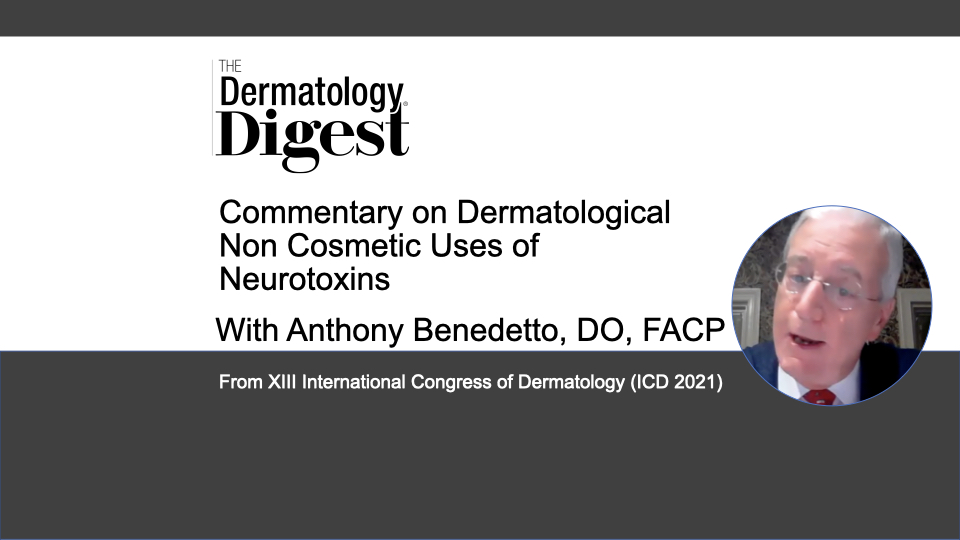Dr. Anthony Benedetto discusses therapeutic uses of botulinum toxin for indications including hyperhidrosis, blepharospasm, and migraine.
“I use botulinum toxins… for cosmetic reasons, but there’s a whole host of reasons why I use them for therapeutic purposes, from blepharospasm [and] migraine headaches to hyperhidrosis,” said Anthony Benedetto, DO, FACP, who presented “Dermatologic Non-Cosmetic Use of Neurotoxins” at the XIII International Congress of Dermatology (ICD 2021).
Of these three non-cosmetic indications, Dr. Benedetto most frequently uses onabotulinumtoxinA (BOTOX, Allergan) for hyperhidrosis in his practice.
“I have treated patients with hyperhidrosis on anywhere from the scalp to the feet and every skin area in between that has eccrine glands that sweat,” said Dr. Benedetto.
Dr. Benedetto uses incobotulinumtoxinA (Xeomin, Merz) for other reasons.
Both are type-A toxins and may be used to treat hyperhidrosis, blepharospasm, and as prophylaxis for migraine headaches.
- onabotulinumtoxinA is FDA approved for severe axillary hyperhidrosis, blepharospasm, and headache prophylaxis in adult patients with chronic migraines.
- incobotulinumtoxinA is FDA approved for blepharospasm, chronic sialorrhea, limb spasticity, and cervical dystonia.
But, Dr. Benedetto cautioned, botulinum toxin is best used to treat smaller, finite areas of excessive sweating rather than those that are more extensive.
“…you can only give so much botulinum toxin in one sitting. If there’s focal or localized areas of sweating, that’s where I use it—the face, the scalp, the inguinal area.”
For treating excessive sweating on larger body surface areas, Dr. Benedetto said oral medication is a better option.
Treatment of hyperhidrosis may be covered by insurance for hyperhidrosis of the palms or axilla, said Dr. Benedetto. In his experience, treatment for migraine headaches, blepharospasm, and hemifacial spasm may also be covered. Coverage is determined by individual healthcare policy and medical necessity when the appropriate criteria are met.
“By and large, the patients who are being treated for those problems have coverage. If they don’t have coverage, it’s expensive… there’s only a few that can afford it and I give them a little bit of a break.”
Botulinum toxin can also be used before or after excisional surgery to improve the appearance of facial scars, particularly in areas of high tension including the forehead and around the periorbital area, said Dr. Benedetto.
“By reducing the vector of tension across the scar, it also helps reduce the tendency for hypertrophic scars, thick scars, [and] red scars. Reducing the redness and tension around a scar helps to diminish inflammation, inhibit excess fibroblast formation, and lessen the tendency for a thick scar.”
Despite research that shows the clinical benefit of using botulinum toxin injections postop to improve the appearance of scars, this treatment approach has yet to become routine, said Dr. Benedetto.
“I think one of the main reasons is that it’s not really covered by insurance and it can be relatively expensive.”
There may also be potential for using diluted botulinum toxin intradermally to treat the redness associated with rosacea, said Dr. Benedetto.
“MicroBotox injections are very, very diluted with the amount of toxin. They have to be injected superficially and they have to be injected in multiple areas.”
This technique delivers less muscle relaxing and wrinkle change, but the wide coverage of the face is said to have a vasosuppressive effect, which minimizes the tendency to flush, said Dr. Benedetto, who learned the technique in Thailand from a well-known dermatologist.
“It’s something that’s kind of impractical, can be a little painful, and it has to be done every two weeks or three weeks—three or four or five times—then the skin does relax. It’s an intradermal [injection] so we’re not affecting the deeper muscles, so it doesn’t change the expression.”
Although Dr. Benedetto admitted that he doesn’t perform the microBotox technique to treat rosacea, he uses a similar injection approach for treating hyperhidrosis of the face.
“I do similar kinds of injections when I do hyperhidrosis of the face… it’s a low dose… [across] the center of the face to the top of the nose, around the lips, the lateral face, [and] even in the forehead.”
The intradermal technique is important to avoid relaxing the levitators and depressors around the mouth, which can result in abnormal smiling and/or drooling.
“With deep injections… you’ll get abnormal smiling. You’ll get the inability to pucker and tighten the lips, so you’ll have drooling and you won’t be able to drink. You can’t go deep. You have to go very intradermally…. It’s a highly diluted dose in multiple areas and in areas where you should not be injecting [deep].”


